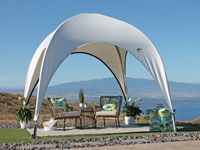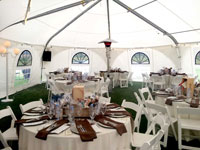Our well-engineered and customizable fabric structures are the world’s first choice among the oil and gas industry, mining operations, remote construction sites and mineral exploration industries.
Alaska Structures® designs the highest-quality health safety structures for remote worksites requiring the most rugged, durable and well-engineered fabric buildings. They’re built tough to keep remote workforces safe in the roughest outdoor elements.
These temporary or long-term remote workforce housing and accommodations are generally referred to as “man camps.”
[Related: Discover the History of Man Camps]
Setting Up Safe and Compliant Man Camps
Alaska Structures designs portable fabric structures and permanent fabric building installations that are rugged and easy to install on any level surface with minimal site preparation. Our fully engineered fabric structures are open-span and meet or exceed the latest local and International Building Code standards.
Our cost-effective and customizable architecture for workforce housing is what helps us lead the oil and gas industry, mining operations, remote construction sites and mineral exploration industries in man camp facilities. All require on-site field offices, man camp housing, and construction storage buildings that withstand extreme weather conditions anywhere in the world.
After almost 50 years of experience leading the industry in fabric buildings, it has been proven time and time again that the most efficient projects — those that stay on schedule, remain organized, maintain comfort in rugged terrains and harsh climates, and those with outcomes that exceed expectations — are those projects that have Alaska Structures® products and supplies on-site.
As with any job, people will often work harder when they feel appreciated by their employers. In addition to physical health, mental health should be a primary concern for remote workforce housing in extreme weather conditions. We engineer the comforts of home that support the mental health and physical safety of your workforce housing.
[Related: How to Create a Positive Culture in Your Man Camp]
This checklist is designed to help anyone setting up a man camp for the first time or reevaluating their existing man camp systems focus on promoting the health and safety of workers.
This guide is for informational purposes only. If planning a camp, we recommend contacting your state or country’s governing agency for industry-specific health and safety standards for temporary and permanent workforce camps.
Man Camp Health Standards
Man camp health best practices include:
- Well-maintained facilities: Facilities should be clean and clear of debris.
- OSHA restroom and sanitation requirements: In addition to the general requirements, OSHA has additional requirements for employers with laborers working in the field.
- Personal protective equipment (PPE): Equipment designed to minimize exposure to hazards that could cause workplace illness or injury. OSHA provides an overview of personal protective equipment as well as standards for general industries, construction, and maritime.
- Barricades and signs for hazardous areas: Dangerous and potentially dangerous areas should be labelled and barricaded off.
- Dust suppression measures and air filters: Man camps in naturally dusty areas and those that produce hazardous chemical dust should implement dust suppression measures and use air filters to prevent health concerns.
- Chemical containment measures: Properly contain chemicals and maintain Safety Data Sheets (SDS) for each.
Man Camp Safety Standards
Man camp safety best practices include:
- Background checks: Complete a full background check on everyone to be employed in any capacity at your man camp — not just a review of social media sites.
- Zero-tolerance policy: Permit no alcohol, drugs, firearms, or physical abuse within the man camp and complete regular drug and alcohol testing to ensure compliance.
- Room segmentation by gender: Separate blocks of rooms or even entire buildings by gender to minimize potential conflict.
- Emergency response and evacuation plans: Have plans in place for responding to emergencies of various types, including plans for evacuating the man camp, if necessary. OSHA provides a publication on how to plan for workplace emergencies and evacuations.
- Frequent safety drills: Carry out regular safety drills, including fire drills and drills for any type of emergency that is likely in the remote location of your man camp (earthquakes, hurricanes, and so on).
- Emergency response agencies: Introduce yourself to and keep in contact with emergency response agencies in the area of your man camp. Updating them on your camp infrastructure ahead of time may help in an emergency later on.
- Safety programs: Consider implementing internal safety programs, such as a reward system for workers who exhibit exceptional risk-mitigating behavior.
- Hazard reporting: Follow OSHA’s hazard reporting procedures whenever incidents occur.
- Entry checkpoint security: Maintain security at all entry points to the man camp, only allow authorized personnel to enter, check all items that are brought in, and keep updated logs of everyone who comes and goes.
- Maintenance logs: Maintain maintenance logs to make it easier to troubleshoot any issues that arise.
- Personal protective equipment (PPE): See above.
- Ample lighting: Provide adequate lighting in all work zones and pathways to avoid hazards.
- MSHA standards: For man camps in the mining industry, the Mine Safety and Health Administration (MSHA) provides standards and regulations as well as safety and health resources.
- ServSafe standards: Ensure that anyone handling food in your man camp dining facilities has the appropriate certifications from ServSafe.
- OSHA standards for safety: These may vary by industry and man camp size.
[Related: How to Create a Positive Culture in Your Man Camp]
Alaska Structures’ Commitment to Health & Safety
Health and safety standards are essential for every man camp, and should extend from policies and processes to the man camp facilities themselves. Alaska Structures® prioritizes the well-being of man camp personnel by designing and engineering fabric buildings for temporary remote camps with their health and safety in mind.
A few of the safety benefits of fabric buildings from Alaska Structures include:
- Durability: Fabric structures from Alaska Structures are engineered for durability to ensure the safety of the personnel and equipment inside. The architectural membranes from Alaska Structures are engineered to have a higher resistance to abrasion, will not rot, and are mold- and mildew-resistant. The frame systems are made of either high-strength galvanized steel or aircraft-grade aluminum, both of which are treated to resist corrosion and engineered to provide the necessary strength to support anticipated seismic, wind, and snow loads.
- Testing and certifications: Our fabric buildings have been proven in the field to withstand extreme climate and weather and are independently tested and verified for proper construction and design. They are designed to meet or exceed local, regional, and international building codes for safety, and our architectural membranes exceed the fire safety requirements outlined in the California Code of Regulations for membrane structures.
- Lighting: All of our fabric buildings come with the option for plug-and-play lighting and electrical systems in 50 Hz and 60 Hz to make it easy to provide the illumination personnel need to work safely. Translucent skylight material also allows you to utilize natural light during the day, creating a bright and safe work environment (and reducing energy usage and costs).
Alaska Structures also designs building solutions with health and safety purposes in mind, creating structures perfect for everything from chemical containment to survival and emergency shelters and medical shelters and mobile field hospitals.
[Related: Guide to Workforce Accommodations in Remote Locations]
Interested in learning more about how our remote camp systems can promote the health and safety of your man camp personnel? Contact Alaska Structures today to speak to one of our knowledgeable building specialists.
Telephone: +1-907-344-1565

















































































Leave a Reply